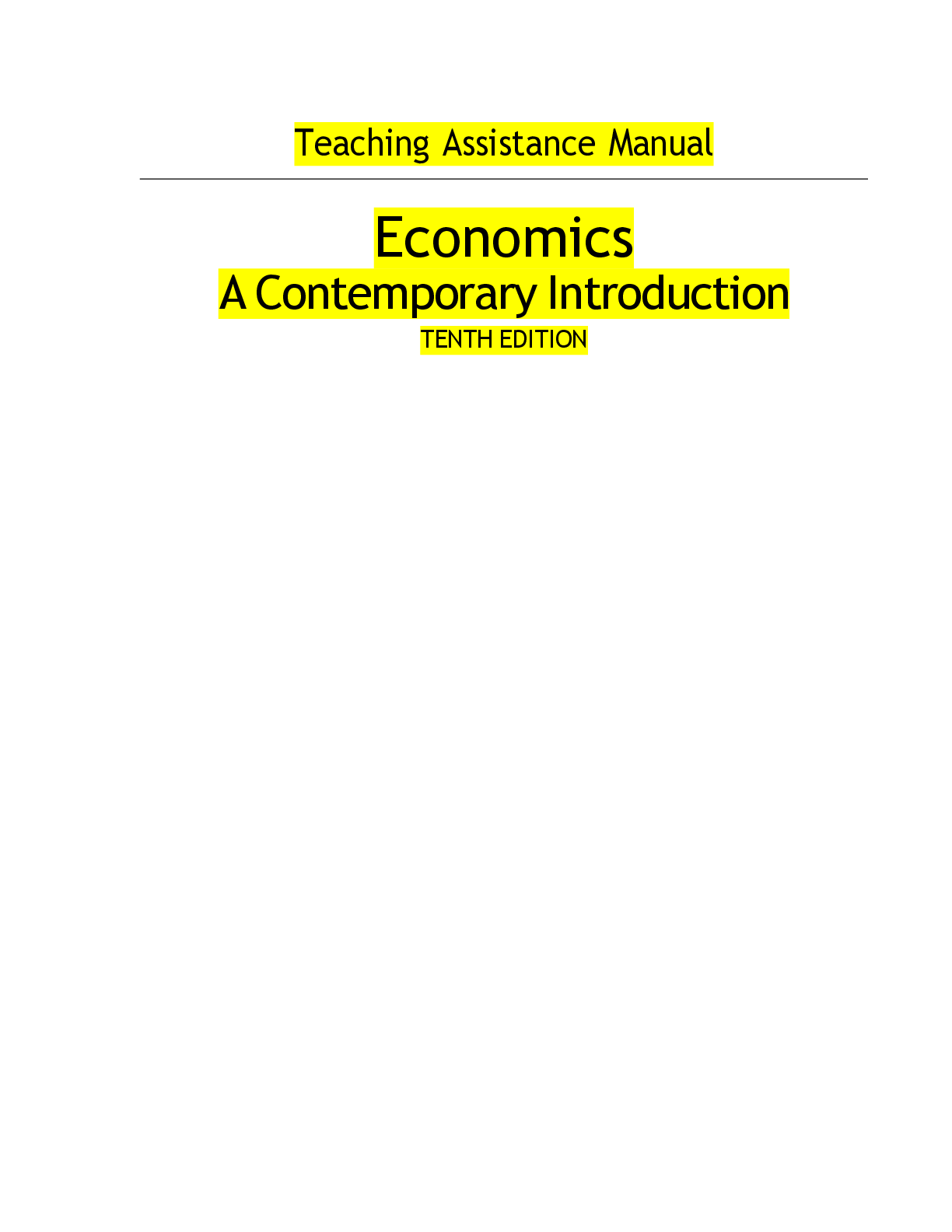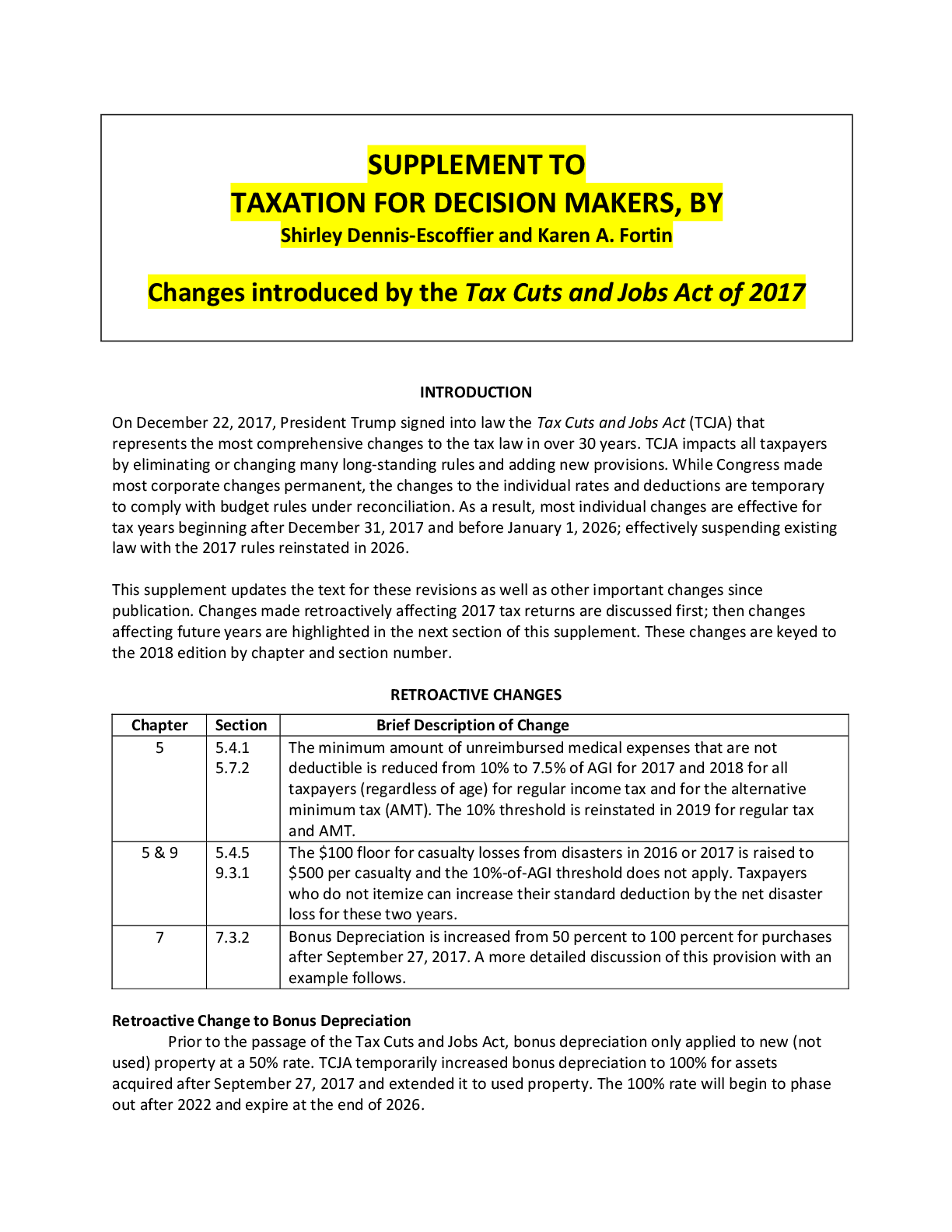Economics > Manual > Teaching Assistance Manual For Economics A Contemporary Introduction 10th Edition William A. McEache (All)
Teaching Assistance Manual For Economics A Contemporary Introduction 10th Edition William A. McEachern
Document Content and Description Below
Teaching Assistance Manual For Economics A Contemporary Introduction 10th Edition William A. McEachern-Lectures represent an effective way to provide large amounts of information, but lectures are mos... tly one-way communications. Since students are often reluctant to ask questions, particularly in large classes, only the looks on their faces and the results of exams provide the instructor with feedback. But this feedback is sporadic, limited, and impersonal. Thus, the instructor often has difficulty gauging how the material is being received. One vehicle for encouraging two-way communications is to carry on more class discussion. If the class is already relatively small—say, 25 or fewer students— discussion can become a regular part of the class. But because principles classes are often large, these classes at some institutions are broken down into small weekly sections, providing students with more individual attention, more time to discuss the material, more of an opportunity to ask questions, and a place to take quizzes. Although many instructors might benefit from this manual, the focus here is on smaller classes, where discussion is possible. Sometimes these discussion sections are directed by graduate students, who are variously referred to as teaching assistants, graduate assistants, discussion leaders, or teaching fellows. Whether seasoned teacher or green graduate student, however, each instructor faces many of the same challenges in the classroom. For some of you, this manual may provide new insights. For others it may simply remind you of things you already know. As Mark Twain said “None of us is smart enough to remember all we know.” To have good ideas in the classroom, we need lots of ideas. In using this manual, think of yourself as a prospector looking for a few good teaching ideas. Each chapter number of this manual corresponds with a chapter in my hardback principles textbook (Economics: A Contemporary Introduction, Tenth Edition). The first 18 chapters of this manual correspond with the first 18 chapters of the micro paperback (Microeconomics); and the final three chapters in this manual correspond with the final three chapters of the Microeconomics. If you are using the macro paperback (Macroeconomics), Chapters 1 through 4 in this manual correspond with those same chapters in Macroeconomics; Chapters 19 through 33 of this manual go with Chapters 5 through 19 in Macroeconomics; and the final three chapters in this manual correspond with the final three chapters of the Macroeconomics. Each chapter in this manual contains(1) a brief overview, (2) a detailed outline, (3) chapter objectives and quiz material, (4) topics for class discussion, (5) warnings about trouble spots in the chapter that warrant special attention, (6) additional examples, and (7) some “What If?” questions. The appendices to this manual provide teaching assistance on (a) presenting material, (b) generating and sustaining class discussion, (c) preparing, administering, and grading quizzes, and (d) the special challenges confronting foreign graduate assistants. Even seasoned teachers may find some of this appendix material helpful. Don’t forget about the other components of the teaching package that could help. The Instructor’s Manual answers all end-of-chapter questions and offers chapter summaries and lecture guidance, including when to use PowerPoint slides. Also available are a Study Guide, Test Bank, downloadable PowerPoint slides, computer-assisted tutorials, on-line help, and my newsletter, The Teaching Economist. Other resources include colleagues, newspapers, periodicals, the Internet, and your daily observations of the economics all around you. Most colleges also offer some sort of teaching support through reference material, teacher counseling, and videotaping for self-appraisal. Many good books and articles have been written about college teaching. The following is a short list of references you may find helpful: 1 Aslanbeigui, Nahid, and Michele Naples, eds. Rethinking Economic Principles: Critical Essays on Introductory Textbooks. Chicago: Irwin, 1996. Brookfield, Stephen D. The Skillful Teacher. San Francisco: Jossey-Bass Inc., 1990. Byrd, Patricia, Janet Constantinides, and Martha Pennington. The Foreign Teaching Assistant’s Manual. New York: Collier Macmillan, 1989. Coyle, Diane. The Soulful Science: What Economists Really Do and Why It Matters. rev. ed. Princeton and Oxford: Princeton University Press, 2010. Haskell, R. E. Transfer of Learning: Cognition, Instruction, and Reasoning. San Diego, CA: Academic Press, 2000. Hoyt, Gail M., and Kim Marie McGoldrick, International Handbook of Teaching and Learning Economics, Cheltenham, UK and Northhampton, MA, USA: Edward Elgar, 2012. Intrator, Sam M. Stories of the Courage to Teach: Honoring the Teacher’s Heart, San Francisco: JosseyBass Inc., 2002. Kirk, Delaney J. Taking Back the Classroom: Tips for the College Professor on Becoming a More Effective Teacher. Des Moines, IA and Seattle, WA: Tiberius Publications, 2005. McKeachie, Wilbert J. Teaching Tips: Strategies. Research, and Theory for College and University Teachers. 11th Ed. Boston, MA: Houghton Mifflin, 2002. Saunders, Phillip, and William Walstad, eds. The Principles of Economics Course: A Handbook for Instructors. New York: McGraw-Hill Publishing, 1990. Szenberg, Michael, Eminent Economists: Their Life Philosophies. Cambridge, England: Cambridge University Press, 1992. Willingham, Daniel T. Why Don’t Students Like School: A Cognitive Scientist Answers Questions About How the Mind Works and What It Means for Your Classroom. San Francisco: Jossey-Bass Inc., 2009. There are many of Web sites on teaching. My textbook has a home page containing a variety of resources at http://www.cengage.com/economics/mceachern. Take advantage of available resources. But experience is perhaps the best teacher. Teaching looks easier than it is. New instructors will fully understand the problems they confront only after having taught for a while. As Emerson said “The years teach us much that the days never know.” In 1980 I began offering a teaching workshop for graduate students in the Department of Economics at the University of Connecticut. Some of the material in this manual was developed in conjunction with that workshop over the years. I thank those who contributed to the discussion over the years. I also welcome comments from all who use this manual. My e-mail address is william.mceachern@uconn.edu. 2 Introduction CHAPTER 1 THE ART AND SCIENCE OF ECONOMIC ANALYSIS This chapter introduces the problem of economics and tries to interest students. Beginning with the economic problem of scarce resources but unlimited wants, the chapter provides an overview without getting into much detail. Many terms are defined along the way, including resources, goods and services, and the economic actors in the economy. The chapter tries to show that economics is found not just in the financial section of the newspaper but is very much a part of each student’s everyday life. This edition defines economic fluctuations in this first chapter, so this can be at least mentioned in the introductory chapters and in the micro chapters. The appendix introduces the use of graphs. CHAPTER OUTLINE 1-1 THE ECONOMIC PROBLEM: SCARCE RESOURCES, UNLIMITED WANTS 1-1a Resources 1-1 b Goods and Services 1-1 c Economic Decision Makers 1-1 d A Simple Circular-Flow Model 1-2 THE ART OF ECONOMIC ANALYSIS 1-2 a Rational Self-Interest 1-2 b Choice Requires Time and Information 1-2c Economic Analysis Is Marginal Analysis 1-2d Microeconomics and Macroeconomics 1-3 THE SCIENCE OF ECONOMIC ANALYSIS 1-3 a The Role of Theory 1-3b The Scientific Method Step One: Identify the Question and Define Relevant Variables Step Two: Specify Assumptions Step Three: Formulate a Hypothesis Step Four: Test the Hypothesis 1-3c Normative Versus Positive 1-3d Economists Tell Stories 1-3e Predicting Average Behavior 1-3f Some Pitfalls of Faulty Economic Analysis The Fallacy That Association Is Causation The Fallacy of Composition The Mistake of Ignoring the Secondary Effects 1-3g If Economists Are So Smart, Why Aren’t They Rich? CASE STUDY: College Majors and Annual Earnings [Show More]
Last updated: 4 months ago
Preview 5 out of 127 pages

Loading document previews ...
Buy this document to get the full access instantly
Instant Download Access after purchase
Buy NowInstant download
We Accept:

Reviews( 0 )
$13.50
Can't find what you want? Try our AI powered Search
Document information
Connected school, study & course
About the document
Uploaded On
Mar 20, 2025
Number of pages
127
Written in
Additional information
This document has been written for:
Uploaded
Mar 20, 2025
Downloads
0
Views
16




